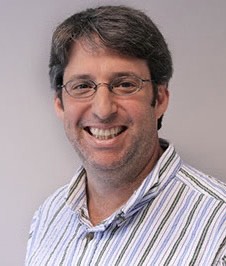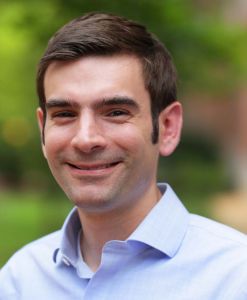January 6, 2025 | By Dave DeFusco
In the 1970s, Dr Thomas Meyer, a newly minted faculty member at UNC-Chapel Hill, concentrated his attention on two key areas of research: how electrons move between molecules—electron-transfer reactions—and the chemistry of certain transition metal complexes, specifically those involving ruthenium and osmium. In order to understand how electrons moved between molecules, he “excited” them by exposing them to light. Collaborating with Dr David Whitten, who had built a specialized tool called a flash photolysis apparatus, they studied how a specific excited state of a molecule—a ruthenium complex, [Ru(bipyridine)₃]²⁺, or Rubipy, could transfer electrons when exposed to light.

Their experiments showed that when the ruthenium complex was excited by light, it could effectively transfer an electron to another molecule called methyl viologen. This reaction was clear and immediate, demonstrating the concept of excited-state electron transfer. What made this groundbreaking was its potential: the energy stored temporarily in the reaction products, the oxidized ruthenium complex and a reduced viologen, was enough to break water molecules into oxygen and hydrogen—a key step in producing hydrogen for clean energy storage.

Dr. Meyer’s breakthrough laid the groundwork for decades of research that established him as an international authority in photochemistry, mechanisms, chemical reactivity and catalysis, and solar energy conversion. In 2008, he co-founded the UNC Solar Energy Research Center (SERC) with Dr. John Papanikolas, now a program director at the National Science Foundation, to provide infrastructure for sustained support of energy storage research at Carolina. The center catalyzed advancements in solar energy and positioned UNC as a leader in renewable energy science by fostering industry collaborations, hosting international conferences and securing significant federal funding.
The first major federal grant obtained under SERC established the UNC Energy Frontier Research Center (UNC-EFRC) to tackle the complexities of solar energy technology. Over the next decade, combined support of the EFRC, National Science Foundation, Advanced Research Projects Agency–Energy and congressional funding would produce 302 publications and six patents, and train more than 200 researchers who went on to careers in academia, industry and government.
A Name Change and Expanded Mission
As the Solar Energy Research Center achieved significant milestones, its leadership recognized that the scope of its mission needed to expand. The scientific community was grappling with ways to mitigate climate change while meeting the world’s growing energy demands, and the challenges of sustainable energy were far too vast to be addressed by solar alone. Energy storage, alternative fuels, grid efficiency and policy advocacy were becoming increasingly integral to the global energy conversation.
In 2022, this recognition led to a transformative moment in the center’s history: its evolution into the Sustainable Energy Research Consortium. This new name reflected a broadened mission and a renewed commitment to interdisciplinary research. Under the direction of Dr Alexander Miller, a professor in UNC’s Department of Chemistry, and Dr. Daniel Kurtz, the consortium’s research project manager, SERC became a hub for addressing the full spectrum of energy sustainability challenges and a symbol of UNC’s dedication to solving complex problems through collaboration and innovation. Researchers from diverse fields, including chemistry, engineering, materials science and public policy, joined forces to tackle challenges that transcend traditional academic boundaries. Since 2009, SERC has attracted $72 million in federal research funding.
“UNC has historically had cross-disciplinary strength in energy science, especially solar energy capture and conversion,” said Dr Miller. “That expertise, together with the strong culture of collaborative research at UNC, has helped support the success of team science projects in the solar fuels space.”
The re-imagined SERC operates on three foundational pillars:
- Facilities and Training Infrastructure: Cutting-edge tools and expertise to drive energy science innovation.
- Collaborative Research Nucleation: Support for team science initiatives that tackle grand challenges.
-
Community Building: Forums to connect academia, industry, government and the North Carolina public, fostering a thriving network of energy stakeholders.
CHASE: A Flagship Initiative
At the heart of SERC’s portfolio lies the Center for Hybrid Approaches in Solar Energy to Liquid Fuels (CHASE), launched in 2020 with a $40 million grant from the U.S. Department of Energy and one of two such Fuels from Sunlight Energy Innovation Hubs in the country.

Dr. Miller said UNC-supported grants management staff in SERC has been “critical” in attracting that kind of federal support. When the EFRC ended, SERC funds provided bridge support for staff and researchers who proved integral to facilitating the formation of a new team to obtain the CHASE grant.
Echoing Dr. Meyer’s earlier work, CHASE’s mission is to develop hybrid photoelectrodes that convert sunlight, water and carbon dioxide into liquid fuels. These innovations hold the promise of a carbon-neutral energy cycle, where fuels can be recycled without contributing to atmospheric carbon dioxide levels.
The goal of solar fuels follows from natural photosynthesis: create and use high-energy molecules on demand, such as hydrogen from water splitting or carbon-based fuels from carbon dioxide. As fuels, they can be stored and used when needed, compatible with existing technologies.

“The biggest barrier is to couple the light harvesting component of photosynthesis with the chemical fuel production component,” said Dr. Jillian Dempsey, deputy director of CHASE and the Bowman and Gordon Gray Distinguished Term Professor. “Both of those individually will be challenging research targets, but finding a way to integrate the science of light harvesting and solar energy capture with the fuel production chemistry is really our major challenge.”
The interdisciplinary CHASE team has already made significant strides, including the development of hybrid photoelectrodes that efficiently produce liquid fuels from carbon dioxide, laying the groundwork for applications that could fundamentally change how society harnesses energy.
Supporting this pioneering work are modern facilities, such as the Solar Fuels Product Analysis Lab and the Molecular Synthesis Lab, which provide essential tools for catalysis and fuel benchmarking and offer opportunities for students to learn technical skills and work with modern instrumentation.

“They serve the broader UNC and North Carolina community,” said Dr. Miller, “and it has been fun to see how chemists in fields adjacent to energy storage have made creative use of the instrumentation to further their projects.”
The implications of CHASE’s work are profound. By creating sustainable liquid fuels, the initiative addresses one of the most significant barriers to the widespread adoption of renewable energy: energy intermittency. This innovation has the potential to reduce reliance on fossil fuels while providing a reliable and scalable energy source for industries like transportation and manufacturing.
Next-Generation Battery Technology
As renewable energy sources, like solar and wind, become more prevalent, the need for efficient energy storage systems has become increasingly urgent. Recognizing this, SERC helped form and support a team of scientists who successfully competed for UNC Creativity Hub funds to launch a new center “Advancing Solid Electrolytes for Next-gen Lithium Batteries,” which is focused on developing battery technologies that can store renewable energy efficiently and sustainably.
“SERC has provided the infrastructure to support our flagship centers—the EFRC and CHASE—and help them thrive,” said Dr. Dempsey. “Recently, the nucleation of a Next-Generation Lithium Batteries Creativity Hub has provided an example of how SERC can translate this model across a broader space of energy science.”
In particular, this Creativity Hub project, under the leadership of Dr. Wei You, a professor of chemistry and applied physical sciences, is focusing on advancing lithium-ion technology to leverage North Carolina’s vast lithium deposits. Led by a diverse team of chemists, materials scientists and engineers, the project aims to develop non-flammable, solid-state electrolytes and high-capacity electrodes, paving the way for safer, more sustainable energy storage.
UNC’s commitment to battery innovation is further demonstrated by the planned Center for Energy Storage, which will serve as a regional hub for battery manufacturing and testing. These efforts align with North Carolina’s energy goals to reduce power sector emissions by 70% by 2030 and achieve carbon neutrality by 2050.
The Center for Energy Storage is expected to attract top talent to the effort and foster collaborations with industry. Energy research has already garnered significant support in North Carolina, including a $15 million allocation made to the NC Collaboratory by the North Carolina General Assembly for energy research and development.

In addition to providing grants to researchers across the state, the NC Collaboratory plans to help institutions recruit faculty with expertise in energy storage research, further strengthening UNC’s leadership in this field.
“We can keep that strength while also expanding our reach to include emerging energy storage areas such as electrochemical energy storage—batteries—and nitrogen fixation,” said Dr Miller.
The commitment to improving lithium-ion batteries will bring together leading UNC faculty, including Dr. Theo Dingemans, chair of the Department of Applied Physical Sciences who specializes in ionic composite materials; Dr. James Cahoon, chair of the Department of Chemistry who is an expert in the chemical synthesis of semiconductor nanomaterials; Dr. Megan Jackson, an assistant professor of chemistry whose lab is focused on renewable energy storage; and Dr. Frank Leibfarth, Royce Murray Distinguished Term Professor of Chemistry and an expert in polymer science.
Dr. You will lead this team of experts in pursuing three main objectives: creating non-flammable, solid-state polymer electrolyte materials; developing high-capacity carbon- and silicon-based electrodes; and increasing capacity for the fabrication and testing of sustainable batteries.
Building Community
SERC’s influence extends far beyond the boundaries of UNC-Chapel Hill. By partnering with local industries, policymakers and community organizations, the consortium plays a vital role in shaping North Carolina’s workforce. By producing graduates skilled in cutting-edge energy science and engineering, SERC is preparing the next generation of leaders for careers in the energy sector, addressing the growing demand for expertise in areas like renewable energy systems design, battery manufacturing, sustainable chemicals and energy policy. The consortium also offers training workshops for local companies, builds pipelines to North Carolina’s energy sectors and opens its facilities to startups, accelerating innovation and economic growth.
Since 2009, SERC conferences have showcased a dynamic progression in addressing challenges related to solar energy, energy storage and synthetic fuels. Initially, these events focused on groundbreaking topics, such as photovoltaics, unmet needs in solar fuels and energy storage, and bridging science, engineering and policy. Over time, the center broadened its scope to include discussions on photonic materials, dye-sensitized solar fuel devices and pioneering research in energy storage and photocatalysis. In the last five years, the emphasis has shifted toward advanced themes like photocatalysis with inorganic materials and synthetic fuels, prioritizing practical applications and cutting-edge research.
In November, SERC hosted the conference, Future Fuels and Breakthrough Batteries, which convened researchers from across the United States in fields related to energy storage, including scientists working on batteries who don’t often interact with those studying synthetic fuels.




“It was extremely exciting to hold the first standalone conference in Chapel Hill since 2017,” said Dr. Miller. “This meeting showed how researchers in different energy storage focus areas can learn so much from each other.”
Leading the Energy Transition
As the world faces the dual challenges of climate change and energy insecurity, SERC seeks to cement UNC’s position as a global leader in the energy transition to renewables. With deep roots established during five decades of fundamental and applied studies of photochemistry, electrochemistry and materials science, SERC is well positioned to support pioneering Carolina chemists.
“UNC has a rich history of research in photochemistry and solar energy, from fundamental studies of excited states to dye-sensitized solar cells to organic photocatalysis,” said Dr. Miller. “We can keep that strength while also expanding our reach to include emerging energy storage areas, such as electrochemical energy storage batteries and nitrogen fixation.”
Through research team nucleation, shared instrumentation facilities and community engagement, SERC can help UNC researchers achieve bold goals.
“Carolina chemistry has long excelled in photochemistry, electrochemistry and catalysis, and has an equally robust tradition of collaboration and mentoring,” said Dr. Miller. “By strengthening collaboration and facilitating innovation, SERC can strengthen this legacy and write new chapters while taking on the global challenge of sustainable energy.”
This article was originally featured in the Department’s 2024 Annual Newsletter. Read more of the newsletter at the link below.


